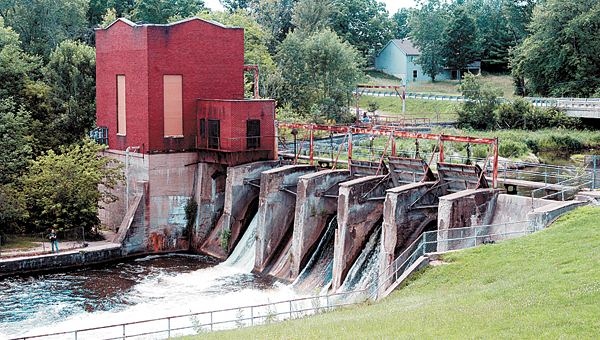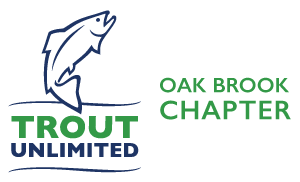MARCY HAMILTON UPDATE ON THE DOWAGIAC RIVER DAM REMOVAL
By Jim Schmiedeskamp
Published May 2017
Marcy Hamilton, Senior Planner with the Southwest Michigan Planning Commission, provides OBTU readers with the following update on the Dowagiac River restoration plans including the removal of the Pucker Street Dam. Marcy spoke to the OBTU chapter about the project at our 2016 May membership meeting.
OBTU: WHAT ARE THE CURRENT PLANS FOR THE PUCKER STREET DAM REMOVAL IN TERMS OF TIMING? WHO IS RESPONSIBLE FOR ITS REMOVAL AND WHY THE REMOVAL?
MARCY: The City of Niles owns the Pucker Street Dam and is responsible for the dam. The City has decided to remove the dam. There are many reasons to remove the dam – financial (cost to repair, liability), social (safety of river users, aesthetics), and environmental (blocks all aquatic passage, disrupts natural transport processes of the Dowagiac River, increases water temperatures above the dam). The City is working with consultants to finish the Environmental Assessment, permitting and final design. The earliest any work would occur with dam removal will be Fall 2017 with in-river work beginning after April 2018. Timing will also depend on TransCanada abandoning 2 pipelines traversing the river upstream of the dam and river conditions.
OBTU: WHAT IS YOUR ROLE IN THE DOWAGIAC RIVER RESTORATION INITIATIVE?
MARCY: I work for the Southwest Michigan Planning Commission (SWMPC). SWMPC’s role in the dam removal has been to assist with City of Niles with grant writing and administration, public engagement and developing the Environmental Assessment. SWMPC currently and over the last 20 years has been a partner in the development of the Dowagiac River Watershed Management Plan, the implementation of re-meandering the Dowagiac at Dodd Park, river clean-ups, outreach and education to landowners and local officials about protecting and improving the Dowagiac River and most recently to conduct a habitat assessment and culvert inventory on the Dowagiac River and its tributaries. SWMPC plans to continue working on watershed protection and improvement efforts and also assist with efforts to increase/improve public access.
OBTU: WHAT WILL THE DAM REMOVAL MEAN TO THE RIVER’S CHARACTER AND FLOOD PLAIN UPSTREAM OF THE CURRENT DAM?
MARCY: The dam removal project will include the restoration of almost 6,000 feet of river upstream and downstream of the dam. Through depth of refusal studies, different channel alignments have been discovered. This project will keep the river in its current alignment and floodplain benches and wetland areas will be constructed. The basic physical processes of water and sediment transport have been impacted by the dam. All physical, chemical, and biological attributes required to develop and maintain a functional river system are dependent on these processes. The removal of the dam will restore these processes and restore the natural character of the river itself. Coldwater streams with high gradient are a rare resource in southern Michigan. Removal of the Pucker Street Dam will restore approximately two miles of this high gradient habitat immediately upstream of the dam.
OBTU: WHAT IS THE EXPECTED IMPACT ON THE DOWAGIAC’S MIGRATORY STEELHEAD AND BROWN TROUT FROM LAKE MICHIGAN DURING AND AFTER THE PROJECT COMPLETION? WHAT WILL BE THE PRIMARY BENEFITS TO THE DOWAGIAC AS A COLDWATER FISHERY?
MARCY: The Pucker Street Dam currently blocks the upstream migrations of fish species such as steelhead, Chinook salmon, coho salmon, brown trout, white suckers, and walleye to more than 159 miles of main stem and tributary habitat. With the dam removal, migratory fish will migrate long distances into the Dowagiac River system and resident species will move seasonally throughout the system in both upstream and downstream directions. Removal of the Pucker Street Dam will restore approximately two miles of high gradient stream habitat on the main stem and will provide migratory fish species with access to existing high gradient stream reaches in tributary streams. Natural reproduction of steelhead, brown trout, coho salmon, and walleye is expected to increase. The dam removal will reconnect more than 150 stream miles and will create new steelhead and salmon fisheries in the main stem and major tributary streams. It also will increase the available spawning habitat for native species such as walleye, suckers, and smallmouth bass.
OBTU: WHAT HAS BEEN THE FEEDBACK FROM GUIDES AND FISHERMEN?
MARCY: The feedback has been mixed. Some of the guides are very supportive of the dam removal and restoration efforts. While others are concerned that the fishery will be negatively impacted. The good news is that many guides and fishermen are bringing their resources and expertise to the Dowagiac River. They are volunteering with the habitat assessment and other improvement efforts in the watershed. It is exciting to see all of the interest in the common goal to improve the river habitat.
OBTU: WHAT ARE THE KEY WORK PHASES AND TIMING?
MARCY: The project’s work phases include:
Data Collection (survey, sediment sampling, sediment volume estimation, sampling for hazardous materials in the dam structure, wetland delineation)—Completed.
Concept Design (vet designs with stakeholders and regulatory agencies merging together desired project goals with the realities of funding)—Completed.
Final Design (development of plans, specifications, and cost estimates, permit applications, environmental assessment)—In progress; 80% completed.
Construction (pipeline abandonment, removal of the dam structure, sediment management and river/floodplain restoration)—Fall 2017 through summer 2018.
Evaluation (track the success of meeting project objectives of restoring natural river processes and increasing fishing and boating opportunities)—2018 – 2021.
OBTU: WHAT KIND OF VOLUNTEER WORK CAN TROUT UNLIMITED CHAPTERS PROVIDE IN SUPPORT OF THE DOWAGIAC PROJECT OVER THE NEXT COUPLE OF YEARS?
MARCY: The Partnership for MEANDRS and Michigan Trout Unlimited are coordinating habitat assessment, a culvert inventory, temperature data collection and fish sampling on the Dowagiac River and its tributaries. Volunteers are needed to complete the assessment work, raise funds for providing local match for grants and in the future work on prioritized habitat improvement projects.


